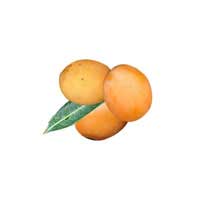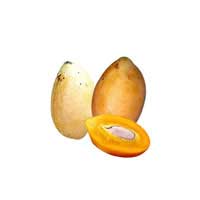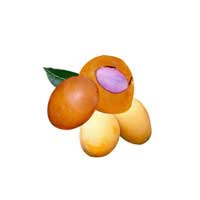 Full List of Fruits
Full List of Fruits  Ma-praang Fruit
Ma-praang FruitMa-praang Fruit
![]() Introduction of Ma-praang Fruit
Introduction of Ma-praang Fruit
Scientific name - Bouea macrophylla
The evergreen tree Bouea macrophylla, having some correlation to the mango is commonly known as Ma-praang, native to Southeast Asia is a tropical fruit tree that belongs to the family of Anacardiaceae. Commonly known as the Marian plum, Gandaria, and plum mango in English, they are also known as ma-praang and ma-yong. The tree grows upto a height of 25 metres, with its leaves ranging from 13 to 45 cm (5 to 17 inches) long and from 5 to 7 cm (2 to 3 inches) wide, the shape of the leaves are lanceolate to elliptic in shape. Indigenous to Malaysia, West Java, Burma and North Sumatra, the tree is also found in various other places like Thailand, Laos, Indonesia, and Malaysia and it is commercially grown out there. With that said, when compared to Indonesia, the flowering and fruiting time differs.
The fruit, when not fully formed is pale green in color and becomes dark green as it develops. Resembling a mango, to state a rough estimation they grow upto 2 to 5 cm (0.7 to 1.9 inches) in diameter. Including the single seed, the entire fruit is edible with a taste ranging from sweet to sour. They give out a very light smell of turpentine. With a bitter and astringent taste, the endosperm is white and pinkish purple.
![]() Nutritional Value of Ma-praang Fruit
Nutritional Value of Ma-praang Fruit
| Vitamins | value |
| Water | 86.6 g |
| Protein | 40 mg |
| Fat | 20 mg |
| Carbohydrates | 11.3 g |
| Dietary fibre | 150 mg |
| Ash | 20 mg |
| Calcium | 9 mg |
| Phosphorous | 4 mg |
| Iron | 0.3 mg |
| â-Carotene | 23 mg |
| Thiamine | 0.11 mg |
| Riboflavin | 0.05 mg |
| Niacin | 0.5 mg |
| Vitamin C | 100 mg |
Not only the fruit is edible, but the leaves of the tree are also edible. They can be consumed raw and at its young stage they can be used in salads. Given that the seed is edible, the endosperm will be bitter in general. The Fruit can be consumed wither raw, or made into dishes such as pickle, compote, or sambal. The fruit at its unripe stage is used to make rojak and asinan. Seeing that it has dense foliage, the entire tree can also be used as an ornamental fruit bearing shade tree.
This tree belongs to the humid and monsoonal tropics, and has been farmed up to elevations of about 850 metres. The plants of Gandaria can tolerate occasional light frosts and it best grows in light and fertile soil. Calcareous soils are disliked by the tree. Approximately 8-10 years from seedling, the tree begins fruiting and it takes 2 - 3 years from grafted plants. With some named varieties, a single tree can yield upto 200kg fruits depending on the germination.


















